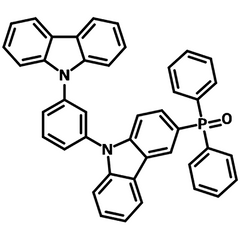mCPPO1
CAS Number 1296229-26-9
High Purity Sublimed Materials, Host Materials, Materials, Semiconducting Molecules, TADF Materials
mCPPO1, bipolar phosphorescent host material for blue, green and red OLEDs
High purity (>99.0%) material used to improve device performance
mCPPO1, 9-(3-(9H-Carbazol-9-yl)phenyl)-3-(diphenylphosphoryl)-9H-carbazole, has a bipolar character with an electron rich 1,3-di(9H-carbazol-9-yl)benzene core unit and an electron deficient diphenylphosphine oxide attachment.
mCPPO1 is an extended family member of mCP with a higher glass transition temperature (Tg = 114.7 °C), and can be used as a phosphorescent host material for blue, green and red organic light emitting diodes. The bipolar charge transport properties of mCPPO1 can effectively balance holes and electrons in the emitting layer, improving device performance.
General Information
| CAS number | 1296229-26-9 |
|---|---|
| Full name | 9-(3-(9H-Carbazol-9-yl)phenyl)-3-(diphenylphosphoryl)-9H-carbazole |
| Chemical formula | C42H29N2OP |
| Molecular weight | 608.67 g/mol |
| Absorption | λmax 324 nm, 338 nm (in DCM) |
| Phosphorescene | λmax 361 nm (in DCM) |
| HOMO/LUMO | HOMO 6.13 eV, LUMO 2.64 eV [1] |
| Synonyms | [9-[3-(9H-Carbazol-9-yl)phenyl]-9H-carbazol-3-yl]diphenylphosphine oxide |
| Classification / Family | Carbazole derivatives, TADF Light-emitting diodes, Organic electronics, PHOLEDs host materials, Sublimed materials. |
Product Details
| Purity | >99.0% (HPLC) |
|---|---|
| Melting point | Tg = 114.7 °C |
| Appearance | White powder/crystals |
Chemical Structure

Device Structure(s)
| Device structure | ITO (70 nm)/4wt% ReO3:mCP (30 nm)/mCP (10 nm)/10wt% (HFP)2Ir(mpic):mCPPO1 (30 nm)/TSPO1 (10 nm)/8wt%Rb2CO3:mCP (30 nm)/Al (100 nm) [3] |
|---|---|
| Colour |
|
| Max Current Efficiency | 27.2 cd/A |
| Max. Power Efficiency | 25.9 lm W-1 |
| Max. EQE | 21.4% |
| Device structure | ITO (50 nm)/PEDOT(CH8000, 60 nm)/TAPC(20 nm)/mCP(10 nm)/mCPPO1:3wt% Ir(dfpypy)dpm (25 nm)/TSPO1(35 nm)/LiF(1 nm)/Al (200 nm) [4] |
|---|---|
| Colour |
|
| Max Current Efficiency | 20.4 cd/A |
| Max. Power Efficiency | 24.7 lm W-1 |
| Device structure | ITO/PEDOT:PSS (45 nm)/TFB (40 nm)/R-QDs:G-QDs* (18 nm, 1:9)/ZnMgO (40 nm)/Al (2 nm)/IZO (60 nm)/HATCN (20 nm)/TAPC (40 nm)/mCP (5 nm)/Firpic:mCPPO1 (30 nm)/TmPyPB (30 nm)/LiF (1 nm)/Al (100 nm) [5] |
|---|---|
| Colour |
|
| Max. Power Efficiency | 20.31 lm W-1 |
| Max. EQE | 26.02% |
*For chemical structure information, please refer to the cited references.
Pricing
| Grade | Order Code | Quantity | Price |
|---|---|---|---|
| Sublimed >99.0% purity | M2335A1 | 100 mg | £250 |
| Sublimed >99.0% purity | M2335A1 | 250 mg | £500 |
| Sublimed >99.0% purity | M2335A1 | 500 mg | £850 |
| Sublimed >99.0% purity | M2335A1 | 1 g | £1450 |
MSDS Documentation
 mCPPO1 MSDS Sheet
mCPPO1 MSDS Sheet
Literature and Reviews
-
External Quantum Efficiency Above 20% in Deep Blue Phosphorescent Organic Light-Emitting Diodes, S. Jeon et al., Adv. Mater., 23 (12), 1436-1441 (2011); DOI: 10.1002/adma.201004372.
- Solution processed deep blue phosphorescent organic light-emitting diodes with over 20% external quantum efficiency, K. Yook et al., Org. Electronics, 12 (10); 1711-1715 (2011); DOI: 10.1016/j.orgel.2011.07.004.
- Highly efficient deep-blue phosphorescence from heptafluoropropyl-substituted iridium complexes, J. Kim et al., Chem. Commun., 51, 58-61 (2015); DOI: 10.1039/C4CC07768G.
